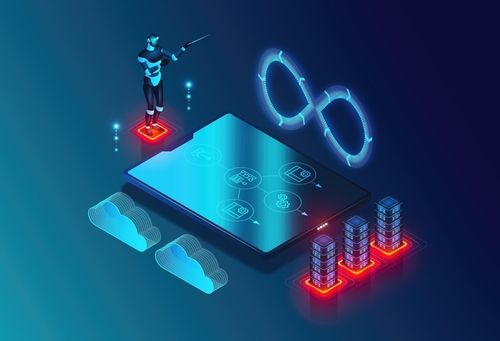Espresso: A strong coffee prepared by forcing hot water through finely ground dark-roast coffee beans

Today, I am preparing to speak at a global supply chain conference for a group of enterprise architects at a global manufacturer. This manufacturer is an industry leader. They want me to speak to the future of Supply Chain Applications. They read my last blog —A Pot of Coffee–and they have challenged me to boil it down to a cup of espresso. In their words, “Cut to the chase, Lora. Give us the key sound bites.”
Here is my first try:
What Will Define the Supply Chains of the Future?
Supply Chains of the future will need to:
-Think and translate in attributes. The architectures will need to quickly detect patterns between market attributes and product attributes. Supply chains need visibility into performance-based outcomes in the channel. This is a stark contrast to what we have today. Architectures today are tightly integrated against the concept of an SKU (a stock-keeping unit) and the information for that SKU is tightly integrated. The architectures are inflexible. As an SKU changes, the history cannot be mapped. As a result, most of our current architectures will become obsolete.
Today, supply chain applications focus on volume translation against SKU and item nomenclatures. The translation of volume to mix applications, and the impact on profitability, cannot be easily determined. Only 11% of companies have sufficient what-if models and only 23% can model profitability of decisions. The current architectures will have to be redefined to think and act based on attribute-based models to see the impact of decisions against the Effective Frontier (the trade-offs between growth, profitability, cycles and complexity).
-Redefine the rules of the game. Change them as you go. Today, the supply chain operates under one-to-one rules. E.g., “If this happens, then do this.” In the future, the supply chain will be able to process multiple ifs and connect them to multiple thens through cognitive learning engines. As a result, Available to Promise (ATP) and Allocation logic will adapt and learn based on market conditions. Additionally, Master Data Management technologies with one-to-one mapping will become obsolete.
-Sense before responding and learn as you go. Today’s supply chains are inside-out. They respond based on order and shipment data. This data does not accurately represent what is happening in the channel. In the future, the translation of daily channel data daily and the visualization of geographic patterns will define the response. Channel data will grow in importance, and the importance of the order will be relegated to back-end collection processes.
-Test. Learn. Act. Adapt. More data, and more varied data, yields additional capabilities. Customer patterns of behavior through transactions and images, and social sentiment will fuse. As we sleep, supply chains will learn globally. They will create and test new hypotheses. The engines will optimize assortment locally for the store of the community. They will develop new patterns daily on new item and category acceptance.
–Translate, synchronize and orchestrate. While companies used to think that the supply chain of the future would be tightly integrated, they now realize that the future is about data translation, synchronization and orchestration. To build value networks, companies will invest in Inter-Enterprise Systems of Record that give a history of the terms and agreements of multiparty commerce at a point in time. This will give rise to a new set of marketplace offerings.
What Will Be the Challenges?
The biggest barrier here will not be the adoption of the technology. It will be the changing of mindset. The enemy is us. There are four main problems:
1) The Functional Leader. The functional leader that thinks that they KNOW BEST PRACTICES. As a result, they will not see that the practices are happening and that new business models are evolving.
Let me give you some specifics. The transformation will be the shift from marketing-driven thinking to market-driven processes. Organizations will have to think holistically about the supply chain end-to-end, as opposed to thinking about the supply chain as a limited function of distribution and logistics.
2) Implementation. Another problem is how we think about technology deployments. The traditional manager thinks of technology implementations as a “waterfall” approach. Mapping of “as is” to “to be” conditions, and the application of technologies in a large project, with a fixed ROI. The investments in new analytics to evolve the supply chain will be about small iterative projects. It will require the investment of funds based on innovation. There will not be a fixed ROI.
3) The Ecosystem. The current ecosystem of analysts, system integrators and technology providers is driven by a traditional model. The research and adoption of these new technologies based on Software as a Service models, and cloud-based analytics will evolve into a very different ecosystem. Payment will be based on usage. Deployment will be as easy as the mobile application on your iPhone. It will challenge the commercial structures of thought leaders and technology providers.
4) Clock speed. Tempo. Rhythm. I used to take piano lessons. On the top of my piano, on the right-hand side, was a metronome. It helped me to move my hands at a different tempo and to understand a new rhythm. The tempo of the supply chain is speeding up. Just as I had to teach myself new techniques to learn to play in moderato to allegretto, the leader of the supply chain team needs to adapt processes to use new forms of data that are arriving more quickly, with less latency, offering more information. It isn’t your father’s supply chain. It does not run via “LARGO” processes anymore. The tempo is changing. There is a new clock speed. Welcome in the world of real-time data. Learn to dance to a new tempo.
What does this mean to the adoption of the SCOR model?
The SCOR model is an inside-out model. It will be helpful for the functional leader, but will not be able to serve as a road map for building outside-in practices.
How does this affect ERP deployments and the definition of the integrated supply chain?
The tightly integrated supply chain (planning to ERP) was a mistake. The greatest advancements in analytics are happening with best-of-breed providers, not with ERP providers. As a result, most companies will need to stabilize their ERP deployments and put them on maintenance, and begin the investment into new forms of analytics.
So, these are my thoughts. What do you think? Did I miss anything?
We would love to hear your thoughts.
Our first Global Summit in Scottsdale AZ on September 11th and 12th, 2013 will enable thought leaders to continue this dialogue. At this conference, we will use our research as a backdrop for supply chain leaders to discuss the future of supply chains. The central themes are many. They include: the use of different forms of data, the impact of the Internet of Things, the evolution of new forms of analytics, 3D Printing and digital manufacturing, risk management, corporate social responsibility, big data, social and the evolution of the collaborative economy.

The Orchestration Shuffle
As approaches in Artificial Intelligence mature, we have the opportunity to orchestrate the supply chain response. Accomplishing this goal, requires the rethinking of work holistically.






